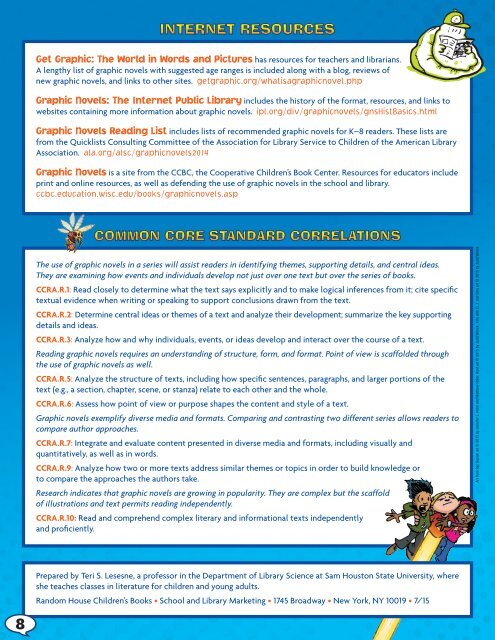UNITE
R2Pqr
R2Pqr
- No tags were found...
You also want an ePaper? Increase the reach of your titles
YUMPU automatically turns print PDFs into web optimized ePapers that Google loves.
Get Graphic: The World in Words and Pictures has resources for teachers and librarians.<br />
A lengthy list of graphic novels with suggested age ranges is included along with a blog, reviews of<br />
new graphic novels, and links to other sites. getgraphic.org/whatisagraphicnovel.php<br />
Graphic Novels: The Internet Public Library includes the history of the format, resources, and links to<br />
websites containing more information about graphic novels. ipl.org/div/graphicnovels/gnsHistBasics.html<br />
Graphic Novels Reading List includes lists of recommended graphic novels for K–8 readers. These lists are<br />
from the Quicklists Consulting Committee of the Association for Library Service to Children of the American Library<br />
Association. ala.org/alsc/graphicnovels2014<br />
Graphic Novels is a site from the CCBC, the Cooperative Children’s Book Center. Resources for educators include<br />
print and online resources, as well as defending the use of graphic novels in the school and library.<br />
ccbc.education.wisc.edu/books/graphicnovels.asp<br />
The use of graphic novels in a series will assist readers in identifying themes, supporting details, and central ideas.<br />
They are examining how events and individuals develop not just over one text but over the series of books.<br />
CCRA.R.1: Read closely to determine what the text says explicitly and to make logical inferences from it; cite specific<br />
textual evidence when writing or speaking to support conclusions drawn from the text.<br />
CCRA.R.2: Determine central ideas or themes of a text and analyze their development; summarize the key supporting<br />
details and ideas.<br />
CCRA.R.3: Analyze how and why individuals, events, or ideas develop and interact over the course of a text.<br />
Reading graphic novels requires an understanding of structure, form, and format. Point of view is scaffolded through<br />
the use of graphic novels as well.<br />
CCRA.R.5: Analyze the structure of texts, including how specific sentences, paragraphs, and larger portions of the<br />
text (e.g., a section, chapter, scene, or stanza) relate to each other and the whole.<br />
CCRA.R.6: Assess how point of view or purpose shapes the content and style of a text.<br />
Graphic novels exemplify diverse media and formats. Comparing and contrasting two different series allows readers to<br />
compare author approaches.<br />
CCRA.R.7: Integrate and evaluate content presented in diverse media and formats, including visually and<br />
quantitatively, as well as in words.<br />
CCRA.R.9: Analyze how two or more texts address similar themes or topics in order to build knowledge or<br />
to compare the approaches the authors take.<br />
Research indicates that graphic novels are growing in popularity. They are complex but the scaffold<br />
of illustrations and text permits reading independently.<br />
CCRA.R.10: Read and comprehend complex literary and informational texts independently<br />
and proficiently.<br />
Art from top: Squish art © 2015 by Jennifer L. Holm and Matthew Holm; Rant art © 2015 by Judd Winick ; Hilo with D. J. and Gina art © 2015 by Judd Winick<br />
Prepared by Teri S. Lesesne, a professor in the Department of Library Science at Sam Houston State University, where<br />
she teaches classes in literature for children and young adults.<br />
Random House Children’s Books • School and Library Marketing • 1745 Broadway • New York, NY 10019 • 7/15<br />
8


